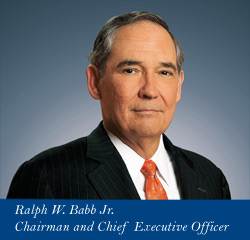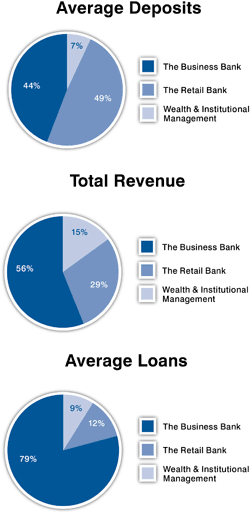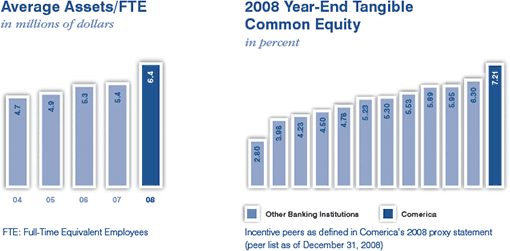To Our Shareholders
 Our nation is grappling with an economic downturn that
has affected individuals, families, and businesses of all sizes.
The challenged environment produced considerable market
turmoil in 2008, as job losses mounted and the national
economy weakened.
Our nation is grappling with an economic downturn that
has affected individuals, families, and businesses of all sizes.
The challenged environment produced considerable market
turmoil in 2008, as job losses mounted and the national
economy weakened.
The U.S. government has taken an active role in trying to shore up consumer and business confidence, and to strengthen our country’s financial system. This has included efforts to increase the flow of credit to households and businesses. By year-end 2008, however, the credit markets still remained strained.
While it was a difficult and tumultuous year, we remained successful by staying close to our customers, and delivering the exceptional service that has been a hallmark of our company through many years and various economic cycles. I will share some of the more notable successes with you.
I also will discuss some of our plans for the future, such as our banking center expansion program, which remains a cornerstone of our deposit-gathering efforts and helps attract thousands of new customers to Comerica. Our plans also include lending to new and existing relationship customers for whom we serve as trusted advisors, particularly small businesses, middle market companies and wealth management clients in the markets we target for growth.
Without a doubt, this is an economic environment that is as unsettling and volatile as any we have ever seen. Our chief economist, Dana Johnson, has been following it closely. Dana does not see a severe or prolonged period of economic contraction, the so-called definition of a depression. Nor does he envision a period of inflation. He does, however, believe we are in the midst of a difficult recession that will continue well into 2009.
For more on Dana’s perspectives, I encourage you to visit the “Economic Insights” area of www.comerica.com. I believe you will find his commentary on the national economy, as well as the Texas, California and Michigan economies, to be enlightening and informative.
In 2008, Comerica followed its business model and executed its strategy, making enhancements to adapt to the changing economy. Our credit management is evidenced in our consistent credit standards, our limits on exposure, and the fact we have had no subprime mortgage programs. Our conservative investment strategy is demonstrated by our primarily AAA-rated and liquid investment portfolio and the lack of off-balance sheet structures, such as structured investment vehicles, that made media headlines. We have a relentless focus on expense management, as well as a conservative expansion strategy. In addition, our size is a competitive advantage in that it provides us the ability to quickly identify issues and to act accordingly. Finally and importantly, in this most unsettling of economic times, the quality of our capital has remained strong.
Fourth Quarter and 2008 Financial Performance
 Jobs, manufacturing, construction and spending declined at an accelerated rate toward
year-end. On an annualized basis, excluding the Financial Services Division — our title and
escrow business — average loans declined 1 percent in the fourth quarter. This was a marked
improvement over the 6 percent annualized decline in the third quarter. Credit quality was
stable when compared to the prior quarter, and expenses continued to be well controlled.
These results underscore our ability to manage through all phases of an economic cycle,
including the current one.
Jobs, manufacturing, construction and spending declined at an accelerated rate toward
year-end. On an annualized basis, excluding the Financial Services Division — our title and
escrow business — average loans declined 1 percent in the fourth quarter. This was a marked
improvement over the 6 percent annualized decline in the third quarter. Credit quality was
stable when compared to the prior quarter, and expenses continued to be well controlled.
These results underscore our ability to manage through all phases of an economic cycle,
including the current one.
For the full-year 2008, we reported net income applicable to common stock of $196 million, or $1.29 per diluted share, compared to $686 million, or $4.43 per diluted share, for 2007. Excluding the Financial Services Division, we grew average loans $2.8 billion, or 6 percent, in 2008, and core deposits grew about $500 million. Our average securities portfolio nearly doubled in 2008. Our credit quality in 2008 compared favorably to the industry.
The driver of the decrease in our yearly income was an increase in the provision for credit losses of $493 million. About half of the 2008 provision was from our commercial real estate line of business, nearly 80 percent of which was related to our California local residential real estate developer portfolio. This portfolio focused on local, smaller residential developers, which built starter and first-time move-up homes.
We made progress in 2008 in reducing the California local residential real estate developer portfolio. We obtained updated independent appraisals to take appropriate charge-offs and established reserves to reflect current market values. We also conducted more frequent credit quality reviews, and moved additional experienced lenders to our special assets group, significantly expanding our workout capacity for these problem credits. Our proactive actions have slowed the rate of deterioration in the portfolio.
As the economy continued to weaken in 2008, we saw some softness among small businesses and middle market companies, the cornerstones of American economic might. This softness was expected, however, and we augmented our reserves appropriately.
A few years ago we made a strategic decision to reduce our exposure to the automotive industry and to diversify to other markets. In light of the challenges now facing this industry, this decision on our part has served us well. We have reduced our non-dealer automotive loan outstandings $349 million in 2008 and by $1.3 billion, or 47 percent, since the end of 2005. This portfolio now represents only about 3 percent of our total loans, and we plan to continue to reduce our exposure to the automotive sector. Net charge-offs for the full year were only $5.5 million in this $1.5 billion portfolio. As always, we consider the challenges the sector faces in taking the appropriate reserves. Our experience in dealing with Michigan’s economic challenges over several years and our strong leadership team have been key to our competitive success in this important market.
Our 2008 earnings were also impacted by an after-tax charge related to our repurchase of auction-rate securities from our retail and institutional clients. Auction-rate securities are long-term variable rate instruments historically viewed as highly liquid investments backed by pools of closedend mutual funds, student loans and municipal bonds. In February 2008, the auction-rate securities market froze and liquidity for these instruments was no longer available. We decided to provide relief for all of our clients by offering to repurchase auction-rate securities from them.
Preserving and Enhancing Balance Sheet Strength
Our Tier 1 capital ratio was 10.66 percent at December 31. In addition, the quality of our capital is solid, as evidenced by a Tier 1 common capital ratio of 7.08 percent and a tangible common equity ratio of 7.21 percent, which is the highest among our peer banks.
We need to preserve and enhance our balance sheet strength in this highly uncertain and unprecedented economic environment. That is why, after careful deliberation, our board of directors decided to reduce the quarterly dividend to five cents per share. We look forward to increasing our dividend when our outlook on the economy improves.
To further strengthen our capital position, we launched a loan optimization program in 2008, which focuses on optimizing the revenue per relationship. The program is working well and producing the desired results.
In October 2008, the U.S. Department of the Treasury announced a voluntary Capital Purchase Program to encourage healthy financial institutions to build capital in order to increase the flow of financing to businesses and consumers, and to support the nation’s economy.
We decided to participate in the Treasury’s Capital Purchase Program up to the maximum amount to further bolster our already strong capital levels. In November 2008, we issued $2.25 billion in preferred stock and a related warrant to the Treasury to complete the capital purchase. The capital we received requires recognition of dividends in 2009 of $134 million after tax, or approximately 89 cents per common share.
We are leveraging our enhanced capital by making loans — with the appropriate credit standards, loan pricing and return hurdles in place — to new and existing relationship customers. This includes small businesses, middle market companies and wealth management clients. The additional capital also enables us to support the battered housing market through the purchase of mortgage-backed government agency securities.
The Federal Deposit Insurance Corporation (FDIC) announced a Temporary Liquidity Guarantee Program in 2008 that is designed to strengthen confidence and encourage liquidity in the banking system. Comerica elected to continue participation in the FDIC program, which provides our customers with a full guarantee, without any dollar limitation, on funds held in all of Comerica’s noninterest-bearing transaction accounts through December 31, 2009. It also provides for a fee a U.S. government guarantee on eligible newly issued senior unsecured debt until the earlier of the maturity date of the debt or June 30, 2012.
Controlling Expenses
Throughout the year, we remained vigilant in controlling our expenses. For example, we are reducing Comerica’s costs for purchased goods and services through improvements to supplier relationships, procurement operations and technology. We have been able to save an average of 10 percent on new and renegotiated contracts. We believe our focus in this area will reduce our operating expense base, enhance our current procurement capabilities, and enable more efficient growth going forward.

We reduced our workforce by about 5 percent since the end of 2007. This was accomplished primarily through the continuous streamlining of operations and the leveraging of technology. As the decline in the economy became more rapid in the fourth quarter, we determined that further staff reductions were necessary. Therefore, we are reducing our workforce by another 5 percent, which will largely be completed by the end of the first quarter of 2009. In addition, we are freezing salaries in 2009 for the top 20 percent of our workforce.
Colleagues whose jobs were eliminated have been encouraged to apply for other positions within Comerica and those who were unable to obtain another position internally have been provided with severance packages, including outplacement services. It is always difficult to say farewell to colleagues, particularly in this economic environment. As with any of our workforce reductions, customers have not been affected. They will continue to benefit from the experience and expertise of relationship managers in all of our major markets.
Strong Focus on Customers
Our strong focus on customers was evident throughout 2008. We surpassed an important milestone in 2008 as we opened our 100th new banking center since the rollout of our expansion program in late 2004. The 100th new banking center is located in Fenton Marketplace, a premier shopping district in the Mission Valley area of San Diego, California.
Among the 28 new banking center locations we opened in 2008 were those in Fort Worth, Texas; Mesa, Arizona; Oakland, California; and Orlando, Florida, in addition to other locations within our growth markets. At year-end 2008, we had 438 banking centers spanning our geographic footprint (see breakdown by market on page 7).
In this uncertain economic environment, we plan to open significantly fewer new banking centers in 2009. All of our new banking centers will be in our growth markets.
Notable 2008 activities within our Retail Bank include the successful launches of two new products: the HealthReserve health care savings account that can help our business customers offer their employees an affordable option for managing their health care expenses; and the EZ Perks rewards program that allows customers to earn points when they sign for purchases made with their Comerica Check Card.
Notable 2008 activities within our Business Bank include surpassing, for the first time, $2 billion in monthly volume with Comerica Business Deposit Capture,SM a product which enables businesses to scan (capture) images of checks at their own locations and transmit them electronically to Comerica for deposit. It provides business customers faster access to their funds and improved record keeping, while also helping to reduce fraud and loss.
We also implemented a new Comerica Business Connect treasury web portal, which features enhanced security through use of token encryption technology. Comerica continues to serve as financial agent for the U.S. Department of the Treasury for DirectExpress® Debit MasterCard,® a prepaid debit card for Social Security and Supplemental Security Income recipients. The card was introduced to millions of recipients throughout the U.S. in 2008.
Within Wealth & Institutional Management, we upgraded our wealth planning division’s technological capabilities to better serve the sophisticated needs of clients. Our wealth station open architecture and tax optimized investment platform provides investors the ability to diversify among asset classes and sectors, helping to mitigate downside exposure to the capital markets.
This past fall, we named 23-year industry veteran Curtis Farmer to lead Wealth & Institutional Management, succeeding Dennis Mooradian, who retired in February 2009. During his five-year tenure, Dennis led important improvements in the Wealth & Institutional Management platform.
Board Appointments
Appointed to the Comerica Incorporated Board of Directors in 2008 were Richard “Rick” Lindner, Jacqueline Kane and Nina Vaca. Rick is senior executive vice president and chief financial officer of Dallas, Texas-based AT&T, which provides communications services in the United States and around the world. Jackie is senior vice president of Human Resources and Corporate Affairs, and a member of the senior management team of Oakland, California-based The Clorox Company, a manufacturer and marketer of consumer products. Nina is chairman and chief executive officer of Dallas, Texas-based Pinnacle Technical Resources, Inc., an information technology services provider which grew under her leadership to become one of the fastest growing and largest staffing firms in the United States. We look forward to their input and expertise as we continue to execute our strategy. Peter Cummings, chairman of Ram Realty Services, and Anthony Earley, chairman and chief executive officer of DTE Energy Company, left our board after 11 and 10 years of distinguished service to our company, respectively.
Commitment to Community, Diversity & Sustainability
Comerica has a strong commitment to community, diversity and sustainability.
We provided more than $14 million to not-for-profit organizations nationwide, including more than $7 million from the Comerica Charitable Foundation, which we fund. Our employees also raised more than $2.35 million for the United Way and Black United Fund. With everything going on in the nation and world, our colleagues once again acknowledged the good work done by local United Way agencies by their outstanding financial support.
Through our financial literacy program, Comerica volunteers educated thousands of students and adults on how to manage their finances, including investing, budgeting and saving.
Our “Cash and Care” campaign enabled our customers to make a difference in their neighborhoods when they opened a qualified deposit at their local Comerica banking center. As part of the campaign, Comerica makes donations to our customers’ designated charities. The program continues to be well received.
Our commitment to diversity also continued in 2008, when we were once again recognized nationally for our efforts in this important area. DiversityInc magazine listed Comerica among the “Noteworthy” companies for diversity and sixth for “Supplier Diversity” — our fourth consecutive year on that particular list. We also were ranked third on Hispanic Business magazine’s “2008 Diversity Elite 60” list, and Latina Style magazine gave us an honorable mention on its “Best U.S. Companies for Latinas to Work For” list.
Thanks to the dedication and hard work of our colleagues, we had a successful 2008 in launching our new Corporate Sustainability Program. We made a good start at embedding sustainable business practices into our operations — practices that will help protect and preserve the environment for those who come after us. And many of our efforts have already begun to improve our business performance by reducing costs and waste — evidence that environmental stewardship is good for business. In August, Comerica learned that it had achieved its first ever listings on nine separate indexes of socially responsible companies maintained by KLD Research & Analytics. In September, we learned that the Carbon Disclosure Project ranked Comerica’s response to the 2008 Carbon Disclosure Project survey #2 among financial service companies in the S&P 500, thereby entitling us to a spot on the Carbon Disclosure Project’s coveted Climate Disclosure Leadership Index.
Looking Ahead
Looking ahead, we will continue to adjust, as necessary, to cope with the pressing economic issues confronting our nation and the world. We will remain vigilant and attentive to the needs of our customers.
Our strong capital base and access to liquidity and deposits will continue to provide us with opportunities to expand new and existing customer relationships and invest in our growth markets.
Our successful relationship banking strategy — built on skill, not scale — continues to be a differentiating strength of Comerica. Our colleagues are committed to delivering the highest quality financial services in this and any other economic environment.
In this most challenging of times, you can expect Comerica to rise to the challenge once again, as it has for nearly 160 years. We will move forward with a purposeful resolve, a clear vision to help people and businesses be successful, and with confidence.
Sincerely,
Ralph W. Babb Jr.
Chairman and Chief Executive Officer